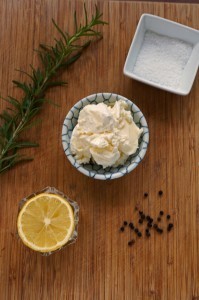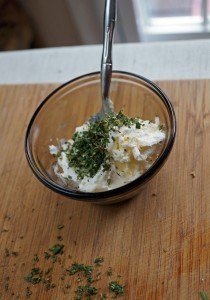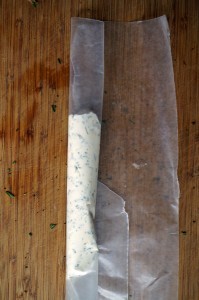Kathleen Flinn's Blog, page 23
June 10, 2013
A Quick Lesson on Roasting Vegetables
Originally posted on CookFearless.com
Years later, several participants in the project at the heart of The Kitchen Counter Kitchen School still say that the lesson on roasting vegetables was a game changer. “My kids will eat vegetables that have been roasted that they wouldn’t otherwise touch,” one of them said. “Plus, once you’ve cut them up and shove them in the oven, they pretty much cook themselves.”
Roasting concentrates and sweetens their flavor and transforms often disliked vegetables such as turnips and Brussels sprouts into sweeter, nuttier and mellower versions of their raw selves. In addition to its hands-free nature, as a bonus, most prep can be done ahead of time. Cut them up, store them in the fridge and pull them out when you’re ready to start dinner. Then all you have to do is toss them with oil and seasonings, spread them on a pan, and check on them occasionally until they’re done. (A few exceptions to the prep rule include those that will oxidize quickly and brown, such as potatoes.)
Easy ways to add flavor
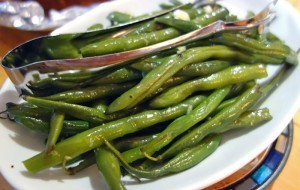
Roasting gives vegetables enough extra flavor that they’re terrific to eat as is—maybe brightened with a dash of lemon juice. Want something more? Whip up a quick vinaigrette or toss with spices (such as this homemade Cajun seasoning) or a finishing butter infused with fresh herbs or a rosemary-thyme-lemon oil. See my Cheat Sheet to Flavor Profiles for more ideas.
In general, when flavoring roasted vegetables (particularly after roasting), avoid any seasoning that has too much liquid lest it soften any crisp edges that develop during roasting.
Four tips for successful roasting
Get your oven hot (450°F to 475°F). The vegetables cook quickly—many vegetables take only 20 minutes—but they still have a chance to brown nicely on the outside by the time they become tender inside. To increase the browning and speed up cooking, you can add your roasting pan or cookie sheet into a hot a oven and get it hot before you add the vegetables.
Aim for even cuts. Unevenly sized pieces won’t roast and brown in the same amount of time, and you’ll end up with both over-roasted and under-roasted vegetables.
Line the pan. To prevent sticking, line the pan with a sheet of parchment, foil or a silpat; otherwise. It eases clean-up and also assures you get all the tasty caramelized bits from the bottom.
Make use of the pan’s edges. Arrange pieces toward the edges of the pan; they’ll brown better.
If you need more servings than a single batch yields, you can easily double or triple these basic roasting recipes. Just don’t crowd the vegetables on the baking sheet—they won’t brown as well if they’re packed too closely. Ideally, there should be at least 1/2 inch between the pieces. Use another baking sheet if necessary and swap the sheets’ positions in the oven about halfway through the roasting time so that the vegetables will roast evenly.


June 7, 2013
Recipe: Homemade Finishing Butters
 Poor Paula Deen. Eater National reports that “midst of a weak attempt at rebranding herself as healthy,” the Food Network star is launching a line of “finishing butters” for WalMart. The woman who made famous a donut-and-egg breakfast sandwich and then came out of the medical closet to announce she had Type 2 Diabetes now has he own line of butter. (To answer your question, yes, she’s still a spokesperson for a brand of insulin.)
Poor Paula Deen. Eater National reports that “midst of a weak attempt at rebranding herself as healthy,” the Food Network star is launching a line of “finishing butters” for WalMart. The woman who made famous a donut-and-egg breakfast sandwich and then came out of the medical closet to announce she had Type 2 Diabetes now has he own line of butter. (To answer your question, yes, she’s still a spokesperson for a brand of insulin.)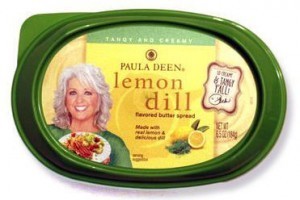
Questions about Deen’s brand management team’s thinking aside, here’s what irks me about this. Her line of butters hasn’t hit shelves yet, but a supermarket source told me WalMart plans to retail them for $3.99 per 6.5 ounce tub — roughly the same price as a pound of decent butter. If you want to choose to make a local and/or organic version, you can do it for less than you’d pay for Deen’s version.
So don’t fall for a plastic tub of doctored-up butter. Save money and do it yourself. If you can let butter sit on a counter, spend two minutes chopping and stir, you can make your own and just keep a few in the freezer to dress up weeknight dinners. I often make compound butter from leftovers — herbs on the verge of going bad, leftover chopped garlic, that last bit of ginger. Just a dab transforms any dish, from meats, fish or chicken, to steamed vegetables and simple pastas.
Lest you wonder, Deen didn’t come up with this concept. Known in French as beurre composé, finishing butter has been around since at least the 1700s. They’re simply unsalted butter that has been blended with herbs and seasonings with endless variations. Auguste Escoffier published three dozen combinations in 1903, among them his famed anchovy butter and beurre à la maître d’hotel (lemon parsley butter).
But as Matt Lauer acknowledged in Deen’s Today spot promoting her finishing butters, the calories still count. Below I’ve included photos from a batch I made and a video from SimpleBites.com to show you the method. Note: I often make small doses of butter and just stir it by hand. Compound butters are also a great way to flavor a roasted chicken, to offer up something special to slather on warm bread and to perk up a piece of fish cooked in parchment.
Recipe: Compound Butter Master Recipe
1 stick unsalted butter, softened
3 tablespoons of your favorite herbs
2 teaspoons lemon juice
1 teaspoon lemon zest
1/4 teaspoon coarse salt
Few grinds black pepper
Let the butter sit at room temperatures until softened. Chop the herbs. Add to the butter and stir or “chop into” the butter until well-incorporated. You can use a stand mixer for this, but it’s not necessary. Place the butter on foil, plastic wrap or wax paper and roll into a long oblong shape. Think of a sushi roll. Place in the freezer for about an hour or until firm. Then slice into pieces and serve with desired dish.
“Hot Butter” with Red Pepper & Garlic
This works especially well to spark up roasted and steamed vegetables.
1 stick unsalted butter, softened
1-3 cloves minced garlic
1 tablespoon chopped parsley
Red chili flakes or dry-roasted chili peppers crushed
1/4 teaspoon salt
Few grinds black pepper
Lemon and Dill Butter
A terrific topper to grilled or pan-fried fish.
1 stick unsalted butter, softened
1½ tablespoons lemon juice
2 tablespoons grated lemon zest
2 tablespoons chopped fresh dill weed or 2 teaspoons dried
Caramelized Shallot Butter
This one is especially nice on roasted vegetables. 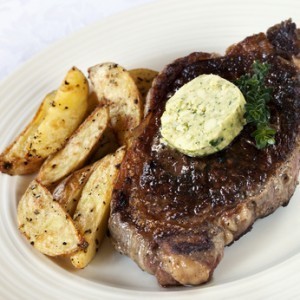
1 stick unsalted butter
2 large shallots, finely diced (1/3 cup)
1 tablespoon chopped fresh thyme or 1 teaspoon dried
1 teaspoon finely grated lemon zest
1/4 teaspoon coarse salt
Freshly ground black pepper
Heat 1 tablespoon of the butter in a small saucepan or skillet over medium-low heat until melted. Add the shallot and cook, stirring frequently, until deeply browned about 10 minutes. Remove from the heat and stir in the thyme. Cool completely. In a small bowl, combine the shallot mixture with the remaining 2-1/2 tablespoons of butter and the lemon zest. Stir to blend well. Lightly season to taste with salt and pepper. Shape into a log as above.
Cognac-Sage Butter
This one is best made with a mixer to emulsify the liquid with the butter
1 stick unsalted butter
1/4 cup tablespoons cognac
1 teaspoon chopped sage
1/4 teaspoon coarse salt
Grinds of black pepper
Bleu Cheese and Garlic Butter
This one is the bomb on grilled steaks.
1 stick unsalted butter
1/4 cup blue cheese
1 tablespoon chopped parsley
2 cloves garlic, minced
1/4 teaspoon coarse salt
Grinds of black pepper
Orange Dijon Butter
This version is terrific on grilled or baked chicken
1 stick unsalted butter
1 tablespoon Dijon mustard
2 tablespoons orange juice
1 teaspoon orange zest
1 clove garlic, minced
1/4 teaspoon coarse salt
Grinds of black pepper
More on CookFearless
A Quick Primer on Herbs & Spices
Cooking in Parchment (video lesson)
How to Roast a Chicken (video lesson)
How to Make No-Knead Artisan bread (video lesson)
More from Fearless Cooks
The Fromagette : A super selection of various compound butters
Brown-eyed Baker : Sweet versions with honey and cinnamon
Cooking Canuck : Great variations including kalamata-mint and curry butter
Food 52 : Tea with Honey and Lemon, plus a great slide show of how to make it


June 3, 2013
The Latest in the Year of Cooking Fearlessly
 “Eat food. Mostly plants. Not too much.”
“Eat food. Mostly plants. Not too much.”
That’s how Michael Pollan started a story for The New York Times Magazine to sum up the strikingly complex question of what humans should eat for maximum health. People seem to be heeding this message. Research shows Americans and Europeans are eating less and less meat. I’ve interviewed dozens of home cooks and how to make small shifts away from a meat-centric diet is a hot topic and not just in other people’s kitchens, but my own.
Two years ago, my mother prompted my husband, Mike, and I to watch Forks Over Knives. In a nutshell, the documentary articulates two separate research studies that demonstrates a strong correlation between meat consumption and cancer, cardiovascular disease and other ailments. After years of Midwest cooking with loads of meat, Mom is what she calls a “Fishka,” a made-up word that sounds Yiddish although she’s solidly Baptist. Essentially, she’s a fish-eating style vegetarian who will not turn down a salad if it’s got a little bacon in it.
Mike and I decided to eliminate most meat form our diets, even going so far as to forego the annual turkey at Thanksgiving. But then, Mike went on a three-day bender sampling Texas barbecue with his friend Jack, then doing research for what’s now known as the Seattle Brisket Experience. I began to test classic Midwest recipes for my third book. (Let’s just say there was a lot of beef involved.) Slowly, surely, we drifted away from our meatless convictions.
My birthday is June 1st. For that, I made a new resolution. To go back to my plant-strong dieting ways. I’m not suggesting giving up meat completely. I’ve got too much of a roast chicken addiction for such a thing. Just cutting back, and trying to focus on making my diet more plant strong.
Hence, this month’s theme of “Love Thy Vegetables” in The Year of Cooking Fearlessly, my ongoing series of cooking lessons, tips and advice, both original and curated from the web to inspire more home cooking over on CookFearless.com. For the next few weeks, I’ll be cross-posting content between the two sites as I redesign the whole shebang to be more integrated.
First up this month: Lesson #24: How to Make Vegetable Stock - Keep those scraps and help save the planet. Really.


May 22, 2013
Hungry for Words? We are, too.

The fruits of Copygate 2013.
Last week, I turned in my third book to Viking/Penguin! They haven’t said they hate it or fired me or whatever the equivalent would be for an author.
After months of writing, editing and recipe testing, I had just enough time for a brief celebratory sigh before moving on to Copygate 2013, the name my assistant Marianne coined for the heroic effort it took to put together massive binders for a weekend-long writing workshop. Somewhere around page 500–with the copy machine’s mechanic lullaby persuading me to near-sleep–a part of me thought, “Why did I schedule this workshop so close to my book deadline?”
But after leading the Hungry for Words writing course, I was reminded of two things: One, how much I love to teach. (I hadn’t led a weekend-long class since 2010.) Two, how quickly complimentary wine and cheese disappears in a room with a bunch of food-obsessed writers.

The aforementioned food-obsessed, a lovely bunch.
You can read more about how it went over at wine writer Jameson Fink’s blog. Or check out the Hungry for Words page here.
If this sounds like the kind of thing you’d be interested in, I have a couple Hungry for Words weekends coming up, one on the east coast in Washington D.C., another in Seattle this September and a third in the works for next January in sunny Florida. Massive binders full of food writing and afternoon wine and cheese included.
Politics & Prose/The Writer’s Center, Washington, D.C.
June 22-23 Register Online
Richard Hugo House, Seattle
Sept. 28-29 (email to be notified of registration)
Anna Maria Island, Florida
January 2014 (email to be put on the list)


April 16, 2013
Hungry for Words Food Writing Course in D.C.
I’ve partnered with acclaimed independent bookstore Politics & Prose and The Writer’s Center in D.C. to offer my weekend-long introduction to food writing camp on the East Coast on June 22-23, 2013.
Known as “Hungry for Words,” this workshop covers a lot of ground in two jam-packed days. We start with a brief look into the history of food writing and its most noted contributors, then shift into a myriad of fast-paced discussion on developing book proposals, writing food blogs, pitching stories to online and print publications and a number of writing exercises. Attendees will leave armed with a thick workbook crammed with writing exercises, examples of great writing, a real-life book proposal and query letters plus an extensive reading list. An online follow-up session for the group is included as part of the program.
Space is limited. To sign up, visit Politics & Prose registration page.
Meanwhile, we’ve made a couple more spots available in the May 18-19 workshop at Richard Hugo House in Seattle.


March 27, 2013
Sous Vide vs. Grilled Steak
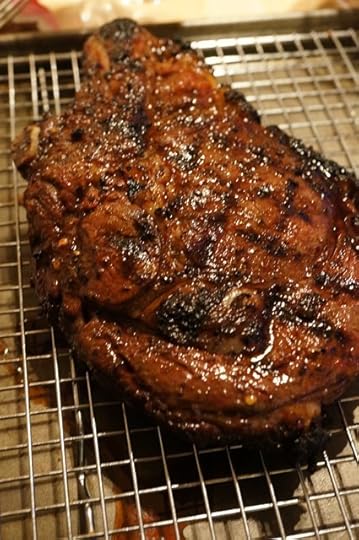
Conventional Grilled Steak
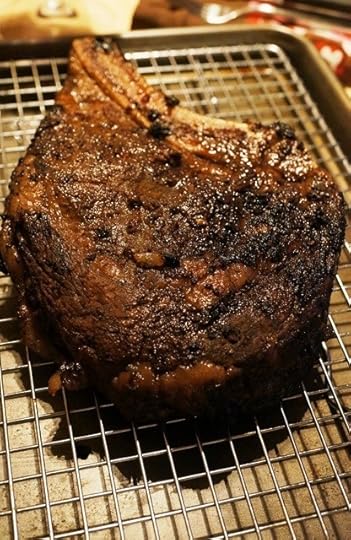
Sous Vide Steak
Last night, our neighbor, Dr. Vince, invited us down for dinner. “We’re doing a competition,” Dr. Vince told Mike. “Steak two ways.”
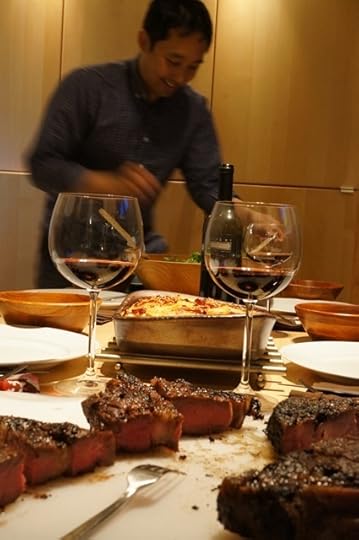
Dr. Vince
Now in classic French parlance, this might mean steak with two sauces, or, say one pan-seared and the other grilled. In this case, it was sous vide vs. conventional grilling. For those unfamiliar, sous vide is the latest gastronomic rage in what’s frequently referred to as molecular or modernist cuisine. In a nutshell: food is put into a sealed plastic bag and then cooked in a water bath at a precise temperature, generally one much lower than used in traditional cooking and for a longer period of time. Sous vide is French for “under vacuum” or “without air.” This is the kind of thing that Dr. Vince does when he’s not working as a medical doctor. For instance, he once invited us over to test two versions of ramen made from different flours. (Ramen made with 00 flour won out.)

Mike’s fabulous gratin, a recipe from CookFearless.com
Dr. Vince borrowed a friend’s spendy sous vide machine. An intellectually curious guy by nature, Dr. Vince followed the finicky directions to the letter. For a fairer comparison, he puts the conventional steak into a sealed bag to marinate, too. The conventional steak was coated with same rub and grilled over a gas grill while the sous vide steak quickly seared over Dr. Vince’s personal toy, a crazy-hot cooker that can generate approximately one million BTUs.
Then, we let them rest for ten minutes and dug in. For the occasion, Mike made this potato gratin from CookFearless, although he substituted in prosciutto for pancetta. The four of us ate nearly the entire pan. Dr. Vince’s wife, Dr. Susan, made an apple pie and a side salad.

Sous Vide up close
The sous vide steak had the classic even cooking throughout that the method is known for. It lost no juice in the cooking process, while the other grilled steak had the traditional trickles of reddish brown liquid seeping from underneath following cooking. The porcini rub was more evident on the sous vide steak. The decision had been made earlier to cook the sous vide steak to just a touch medium; the conventional steak was a perfectly cooked medium-rare.

Convention steak left, Sous Vide on right
The conclusion? Generally inconclusive, but in this test, at least, the conventional grilled steak got the best marks. The table wasn’t overwhelmed by the sous vide version, which had the solid, evenly cooked texture that you find in slow-cooked meats, such as smoked brisket or barbecued pork. The conventional steak had more flavor, arguably some of it imparted from the caramelizing factor from the fire. It also had better mouth feel. But, the sous vide steak was cooked to a higher internal temperature. What if it, too, had been cooked medium rare? Or finished on the grill, instead of a crazy-hot iron skillet? Ah, another test, another time.


March 4, 2013
Recipes by Radio
 Another story from the upcoming book. This one, about the voice that reminds me of my childhood. The last I heard, she was retired and living in Arizona.
Another story from the upcoming book. This one, about the voice that reminds me of my childhood. The last I heard, she was retired and living in Arizona.
Every morning when my mother wasn’t working, she’d park in front of our radio and listen to “Party Line,” later “The Betty Clarke Show” on WFDF-AM in Flint. The host was a folksy, pragmatic woman from Flint’s sister city, Hamilton, Ontario. Her real name was Betty Monas, but the station management prompted her to come up with something more memorable. In the 1950s and ‘60s, the show focused on household hints and recipes, the usual fodder of “women’s show” material back in the day. At least once during her show, she’d offer a recipe by reading through the ingredients list, pausing to allow enough time for the listener to write it down before moving onto the next item on the list. Literally, it was “One cup of sugar” (pause) “One teaspoon baking powder” (pause) “One teaspoon salt.”
My mother would sit at our kitchen table and sit listening to the show, pen in hand. She’d write down her tips for removing stains, gardening or saving money on groceries. But mainly, she waited for the recipes. They weren’t fancy. Dump-and-stir cakes, casseroles, variations on meatloaf, that sort of thing. But every so often, she’d introduce listeners to some culinary novelty, such as risotto or stir fry. When such situations arose, she’d go to The Flint Library to research items such as “soy sauce” since listeners in Michigan weren’t likely to be familiar with such culinary oddities.
In the 1970s, a listener survey discovered she had as many male listeners as women, a surprise to everyone involved with the show. The station restructured her program to include guests who took on more broad topics, stretching to include discussion of news and politics, sometimes inviting the mayor of Flint on as a guest. She also became the official spokesperson for Hamady’s, a supermarket chain in the greater Flint area.
What Clarke was trying to do reminds me of what many bloggers are doing today. They’re friendly, approachable, they ask questions, take comments and try to build a bit of community.
As my cousin Gary Flinn, a columnist for The Flint Journal, wrote back in 2008:
“In her last broadcast in 1983, Betty Clarke ended the show on a personal message. After 30 years of championing domestic tranquility, she reminded her listeners that at the end of the day, there’s a reason why you keep house in the first place, namely to make a home for the people you love. A woman once told her she didn’t worry about what friends thought of housekeeping because “if they are my real friends, they’re never going to look under my bed for dust.” Of course, she still stayed on message, admonishing her listeners not to become “lax” in their domestic affairs. “But you keep house to make a home. Make sure to let them know how much you love them, before it’s too late.”


February 27, 2013
Upcoming Works-in-Progress Readings with Food, Cocktails, Prizes and More
Chapters deep into my next book, a memoir with recipes from my Midwest childhood, I’m ready to hear feedback on what I’ve spent months – and in some ways – a lifetime pulling together. So I’m planning a couple works-in-progress readings at Seattle’s Richard Hugo House for Tuesday, March 19, and Wednesday, April 17. Friends and family kindly offered invaluable advice on my first two books. Readings for the new book, tentatively titled Burnt Toast Makes You Sing Good (slated for publication by Viking/Penguin in early 2014), will be open to the public for the first time.
We’ll taste samples of recipes from the upcoming book, some fun door prizes and a few signed cookbooks that you can purchase as part of the silent auction. Cash bar and free food begin at 6:30, reading starts at 7 p.m. with a short break at 7:45. We’ll finish up around 8:45 p.m. The event is free. Bring a friend. Each reading will have different material, so feel free to come to both! To help me with numbers, it would be great if you could RSVP.


February 15, 2013
Registration Open for “Hungry for Words” Food Writing Weekend May 18-19.
Registration opened this week for the two-day introduction to food writing weekend that I call “Hungry for Words.” I’ll be teaching this intensive, hands-on session at the Richard Hugo House in Seattle. Cost is $290 for Hugo House members, $261 for non-members. I also ask for $22 from each student to cover breakfast both days, lunch on Saturday and wine and cheese in the afternoons. Class size is limited to 15 and it generally sells out, so if you’re interested, jump on it right away. We cover a lot of territory, from the history of food writing, writing with all five senses, the fundamentals of recipe writing, how to put together a book proposal, food blogging, and breaking into food writing as a career among the topics covered. Here’s where you sign up.
I’m finalizing a second food writing weekend in Washington, D.C. The tentative dates will be June 22-23rd. That session will be sponsored jointly by the famed bookstore Politics & Prose and The Writer’s Center. Details on that when sign-ups begins. If you want to be put on a list to notify you when I’ll be teaching various food writing sessions, just drop me an email.


February 11, 2013
I Think We’ve Found the New Pope
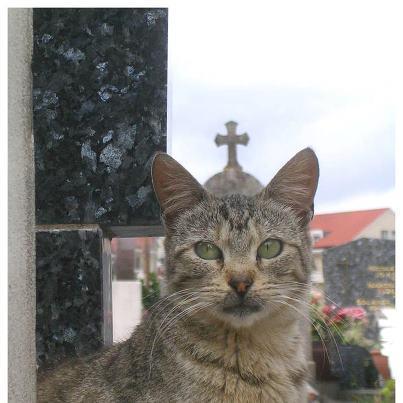
I never share cat photos, but I had to share this one, especially on the news that the present Pope is retiring. As it happens, this cat is in Rome. Coincidence? I think not.
Forgive me if this strikes anyone as blasphemy. I’m only Catholic by marriage; otherwise, I’m a lapsed Baptist.
I’m in bed with a serious flu and still recovering from ripping all the ligaments in my right ankle, struggling to write on book deadline. I saw this photo and laughed out loud enough to scare my dog. So everyone, especially those entrenched in snow in the Northeast, I’m wishing you a good week even if things aren’t going the way you’d hope.




